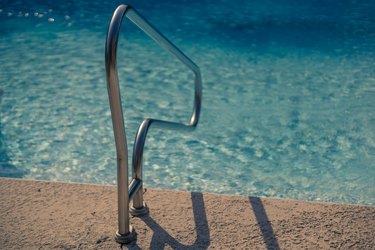
After a heavy rain, you may need to remove some water from your in-ground pool to prevent an overflow and subsequent damage to the pool decking and surrounding foliage. You may also have to remove water if you inadvertently leave the hose on and overfill the pool or if you're getting your pool ready for winter. You might be able to lower the water level using the multiport valve on your filter or the drain spigot on your pump, if the pool has either of these. If not, you can use a submersible pump, or siphon water out with a garden hose.
Using the Multiport Valve
Video of the Day
If your pool has a sand or DE filter, it also must have a multiport valve, which is used to backwash the filter when it gets dirty. You can use one of two settings on this valve -- Backwash and Waste -- to drain water out of the pool. Both settings send water out of the drainage port. The difference is that Backwash sends the water backward through the filter while Waste bypasses the filter altogether. Use the Backwash setting if you want to use the water to clean your filter as it drains.
Video of the Day
Using the Pump Drain Plug
A pool with a cartridge filter doesn't need a multiport valve, because you can remove the cartridge when it needs cleaning. The pump may have a drainage spigot, though, and if so, it should be between the pump and the filter. Connect a hose to the spigot; open it, and the pump will do the rest.
Using a Submersible Pump
A submersible pump is designed to work underwater, and you may already have one to keep your pool cover dry in the winter. You simply connect a drain hose to the pump, and then drop the pump into the pool and let it sink to the bottom. Plug it in, and it will pump water through the drain hose to a drainage area. Use this option when you don't have a drainage spigot or multiport valve.
Siphoning Water from the Pool
In a pinch, you can drain water from your pool using nothing but a garden hose. Simply drop one end of the hose into the pool and bring the other end to a lower elevation, such as down the pool stairs.
You need to create negative pressure in the hose to get the flow started. You can often do this by letting the free end drop quickly or sucking on the end of the hose. If you find the idea of sucking pool water distasteful, fill the hose with water and screw a nozzle on one end. Immerse the uncovered end in water; carry the end with the nozzle to the drainage point and unscrew the nozzle. The flow of water through the hose will create the negative pressure you need to get the drainage process started.
Drain Water Responsibly
Lowering the level of even a moderately sized 20-by-20-foot pool by 4 inches means draining almost 1,000 gallons of water. This much water can create flooding problems for you and your neighbors. To avoid such problems, make sure the water goes into a drainage sewer or out into the street. If you live in the country, find a natural drainage pathway that will carry the water safely away.
Tips for Winterizing Your Pool
If you're draining your pool to get it ready for winter, here are a few things to remember:
- Let the chlorine level fall to less than 1 ppm before draining to avoid introducing chlorine into the environment. After you're finished draining, balance the pH and add more chlorine to the pool to bring the level back to between 1 and 3 ppm.
- If your pool has a vinyl liner, avoid draining it completely. This can cause the liner to loosen and possibly crack in the cold winter weather. If you have a gunite or tile liner, and you're covering the pool with a tarp or solid cover, you only need to drain the water to just below the skimmer level. Be sure to put a pump on the cover to keep it drained during the winter.
- Once the water level has fallen below the skimmer, turn on the pump for a few minutes to drain the pipes.
- Do not leave the pool lights partially covered with water. This can cause them to break during the winter. They should be either completely exposed or completely submerged.